Kuraray Bundle
How Did Kuraray Company Become a Global Chemical Powerhouse?
Delve into the Kuraray SWOT Analysis to understand the strategic landscape of this fascinating Japanese company. From its humble beginnings in 1926 as Kurashiki Kenshoku Co., Ltd., Kuraray's story is one of relentless innovation and a commitment to improving lives through advanced materials. This chemical company has consistently pushed boundaries, evolving from synthetic rayon to a diverse portfolio of products.
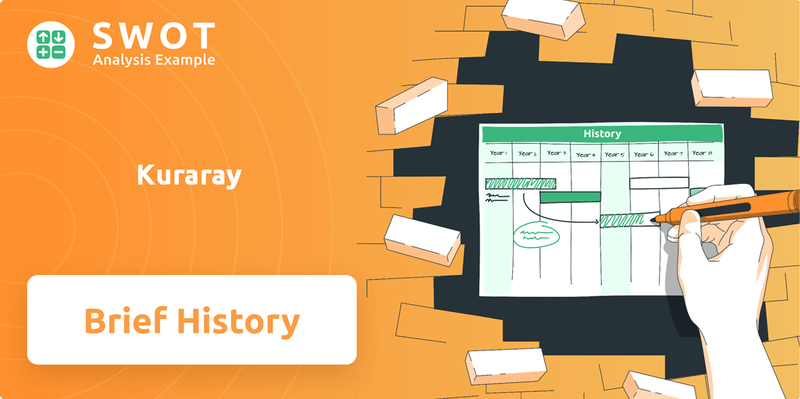
This brief history of Kuraray Company unveils a remarkable journey of pioneering advancements. The company's early focus on synthetic fibers laid the groundwork for its future success in polymers, resins, and more. Today, Kuraray's global presence and dedication to research and development continue to shape industries worldwide, making it a key player in the chemical sector, particularly with its impact on PVA resin.
What is the Kuraray Founding Story?
The Kuraray Company, a prominent Japanese company, traces its roots back to June 1926. Initially named Kurashiki Kenshoku Co., Ltd., the firm was established by Magosaburo Ohara.
The founding of Kuraray represents a pivotal moment in the Kuraray history. It marked the company's entry into the commercialization of synthetic rayon, a groundbreaking innovation in the early 20th century. Kuraray's early focus on artificial silk set the stage for its future endeavors in the chemical industry.
Kuraray's story is a testament to the vision of its founder and his commitment to social responsibility, which extended beyond mere profit-seeking. Ohara's initiatives included improving the living and working conditions of his employees.
Magosaburo Ohara's vision extended beyond business, emphasizing employee and community well-being.
- The company was founded in Kurashiki City, Okayama Prefecture, Japan.
- The initial product was synthetic rayon, a form of artificial silk.
- Ohara prioritized employee welfare by providing accommodation, fitness facilities, and nursery schools.
- He established the Kurashiki Central Hospital and the Ohara Museum of Art.
Ohara's dedication to his employees was evident in his actions. He ensured the construction of decent accommodations, fitness facilities, and nursery schools for employees and their families. This commitment to employee welfare was a defining characteristic of the company's early years.
Further demonstrating his commitment to community well-being, Ohara established the Kurashiki Central Hospital, one of the largest general hospitals in western Japan. Additionally, he invested in cultural projects, such as the Ohara Museum of Art, the first private museum of Western art in Japan. The name, KURARAY, is a combination of Kurashiki and Rayon, reflecting its origins.
To foster technological advancement, Kuraray established the Kyoko Research Laboratory, managed by the University of Kyoto. This strategic move aimed to develop the necessary technologies internally, rather than relying on external expertise. This focus on research and development has been a key factor in Kuraray's innovation and growth.
Kuraray SWOT Analysis
- Complete SWOT Breakdown
- Fully Customizable
- Editable in Excel & Word
- Professional Formatting
- Investor-Ready Format
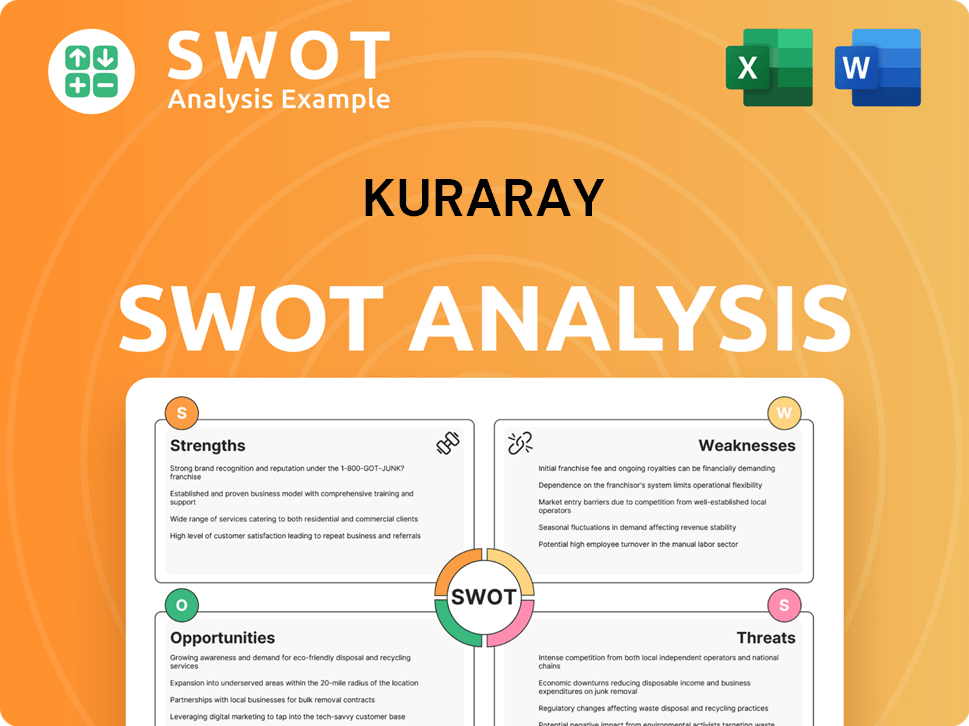
What Drove the Early Growth of Kuraray?
The early growth of the Kuraray Company was characterized by significant advancements in synthetic fiber production. Initially focused on rayon filament, the Japanese company expanded its manufacturing capabilities. A pivotal moment came in the 1950s when Kuraray became the first in the world to commercialize polyvinyl alcohol (PVA) fiber, known as KURALON™. This innovation was a key step in the company's early development.
In the 1950s, Kuraray's introduction of KURALON™ marked a significant milestone. This PVA resin fiber was the first synthetic fiber produced in Japan. It played a crucial role in replacing cotton in student uniforms. This helped ensure a stable supply of fabric.
The 1960s saw Kuraray diversify its product range. The chemical company commercialized polyester using external technology and independently developed man-made leather, CLARINO™. The company also expanded internationally, exporting PVA fiber plants to China.
The 1970s saw Kuraray enter new business areas, including synthetic isoprene chemical products and medical businesses. These included contact lenses, artificial organs, and dental materials. The company also introduced the gas barrier resin EVAL™.
Kuraray continued its strategic global expansion in the 1980s. This included establishing a joint venture in the U.S. for EVAL™ manufacturing and marketing. Throughout this period, the company shifted from fiber production to a broader chemical product portfolio.
Kuraray PESTLE Analysis
- Covers All 6 PESTLE Categories
- No Research Needed – Save Hours of Work
- Built by Experts, Trusted by Consultants
- Instant Download, Ready to Use
- 100% Editable, Fully Customizable
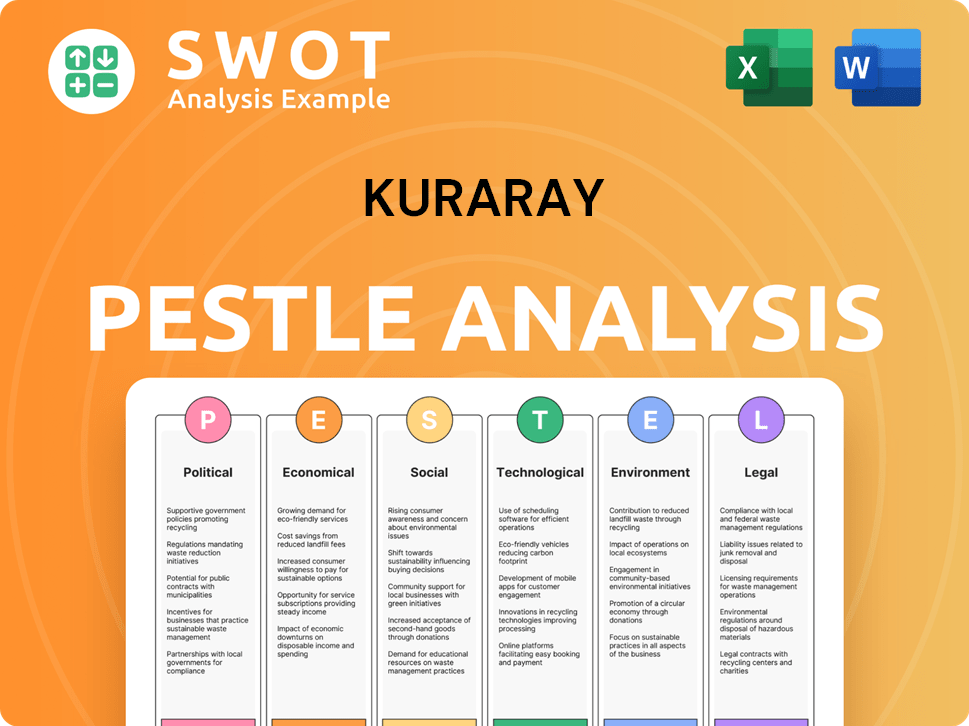
What are the key Milestones in Kuraray history?
The Kuraray Company has a rich history marked by significant milestones, innovations, and strategic responses to challenges in the chemical industry.
| Year | Milestone |
|---|---|
| 1950 | Commercialized KURALON™ (PVA fiber), a foundational product for the Japanese company. |
| 1981 | Invented MDP monomer, improving bond strength in dentistry. |
| 1983 | Launched PANAVIA™ EX, a product based on the MDP monomer. |
| 1990s | Commercialized SEPTON™, KURALON K-II™, and GENESTAR™, expanding product lines. |
| 2000s | Expanded overseas business, including acquisitions in Germany and the U.S. |
| 2010s | Solidified global presence through M&A and alliances, becoming a specialty chemical company. |
| 2024 | Operated a new optical-use poval film production line in Kurashiki. |
The company's innovations include the world's first commercialization of KURALON™ (PVA fiber) and the invention of Phenyl-P and MDP monomers, which revolutionized dental adhesives. Recent advancements involve new production lines for optical-use poval film and expansions in EVOH resin and isoprene production.
In 1950, Kuraray achieved a significant milestone by commercializing KURALON™ (PVA fiber), a groundbreaking innovation that laid the foundation for its component engineering approach.
Kuraray's development of Phenyl-P and, later, MDP monomer in 1981, significantly improved bond strength to dental hard tissue and metal.
The 1990s saw the commercialization of thermoplastic elastomer SEPTON™ and heat-resistant polyamide resin GENESTAR™, expanding the company's product portfolio.
The 2000s and beyond witnessed accelerated overseas business development, including acquisitions and expansions in Europe and the U.S.
In 2024, Kuraray started operating a new optical-use poval film production line in Kurashiki, showcasing its commitment to innovation.
Kuraray is expanding its production capacity for EVAL™ EVOH resin in Belgium and the U.S., with a new isoprene plant commencing operations in Thailand in 2023.
Kuraray has faced challenges, including market downturns and the need to adapt to changing business environments, such as the impact of the 1973 oil crisis. In fiscal year 2024, despite a 5.9% increase in net sales to ¥826.9 billion ($5.4 billion), net income decreased due to extraordinary losses.
Kuraray has experienced challenges related to market downturns, which have influenced its financial performance over the years.
The oil crisis in 1973 significantly impacted the demand for commercial PVA resin, presenting a notable challenge.
In fiscal year 2024, while net sales increased, net income attributable to the parent decreased by 25.3% to ¥31.7 billion due to extraordinary losses.
The company is working on building a sophisticated business portfolio, which includes efforts to address challenges and improve financial outcomes.
The ongoing medium-term management plan, 'PASSION 2026,' focuses on building a sophisticated business portfolio and investing in high-growth potential products.
For fiscal year 2025, Kuraray projects net sales of JPY 860 billion, operating income of JPY 90 billion, and net income attributable to owners of the parent of JPY 45 billion.
Kuraray Business Model Canvas
- Complete 9-Block Business Model Canvas
- Effortlessly Communicate Your Business Strategy
- Investor-Ready BMC Format
- 100% Editable and Customizable
- Clear and Structured Layout
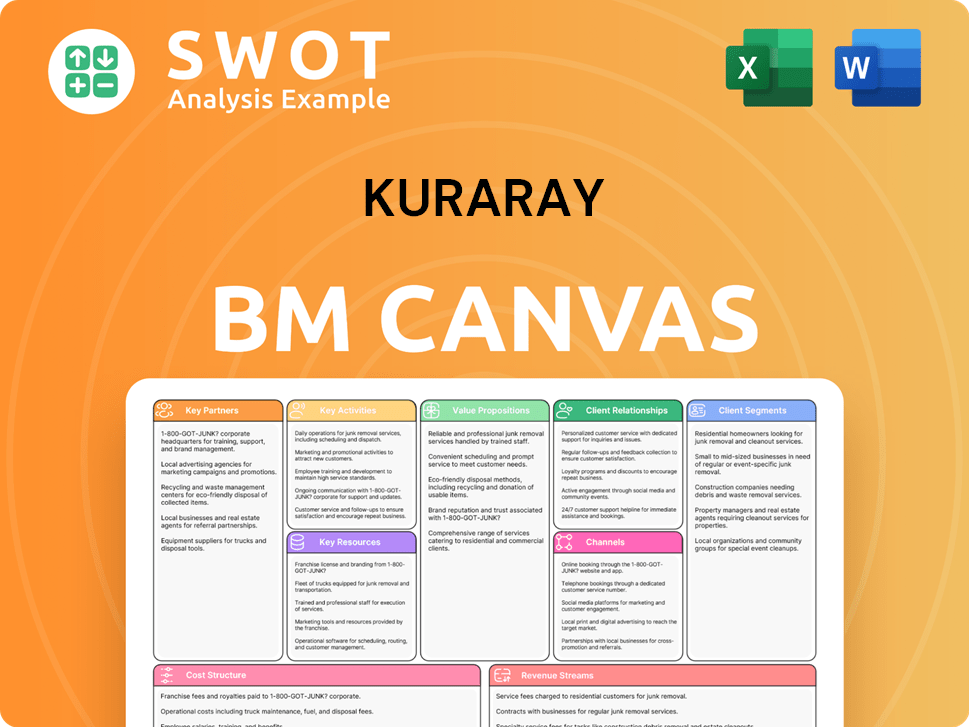
What is the Timeline of Key Events for Kuraray?
The Kuraray Company, a prominent Japanese chemical company, has a rich history marked by significant innovations and strategic expansions. Founded in 1926 as Kurashiki Kenshoku Co., Ltd., the company initially focused on commercializing synthetic rayon. Over the decades, Kuraray has achieved several milestones, including the world's first commercialization of polyvinyl alcohol (PVA) fiber, KURALON™, and the development of groundbreaking products in medical and dental fields. The company's global presence expanded through joint ventures, overseas facilities, and strategic mergers and acquisitions.
| Year | Key Event |
|---|---|
| 1926 | Kuraray was founded as Kurashiki Kenshoku Co., Ltd. in Kurashiki, Japan, to commercialize synthetic rayon. |
| 1950 | Kuraray commercialized the world's first polyvinyl alcohol (PVA) fiber, KURALON™. |
| 1960s | The company commercialized polyester and man-made leather CLARINO™ and exported PVA fiber plants to China. |
| 1970s | Kuraray commercialized the world's first synthetic isoprene chemical products and established medical businesses. |
| 1978 | CLEARFIL™ LINER BOND F, the world's first dentin bonding agent, was released. |
| 1980s | An EVAL™ manufacturing and marketing joint venture was established in the U.S. |
| 1990s | SEPTON™, KURALON K-II™, and GENESTAR™ were commercialized, and EVAL™ and PVA resin facilities were established in Belgium and Singapore. |
| 2001 | Kuraray actively pursued overseas M&As in the vinyl acetate-related business. |
| 2012 | Kuraray Medical Inc. and Noritake Dental Supply Co., Ltd. merged to form Kuraray Noritake Dental Inc. |
| 2017 | The company acquired Calgon Carbon, an activated carbon maker. |
| 2023 | A new plant for the isoprene business commenced operation in Thailand. |
| 2024 | An optical-use poval film production line went into operation in Kurashiki, Japan; a new plant for water-soluble PVOH film started operation in Poland; expanded production capacity for EVAL™ EVOH resin in Belgium; started operation of virgin activated carbon production line in the U.S. |
Kuraray projects net sales of JPY 860 billion for 2025. The company anticipates an operating income of JPY 90 billion and a net income attributable to owners of the parent of JPY 45 billion. These figures reflect the company's strategic initiatives and growth plans.
The company plans to start operation of a VECTRAN™ liquid crystal polymer fiber production line in Saijo, Japan, in 2025. In 2026, Kuraray plans to expand production capacity for EVAL™ EVOH resin in the U.S. and Singapore and start operation of inorganic dental material production facilities in Miyoshi, Japan.
Kuraray's 'PASSION 2026' plan aims for sustainable growth and the realization of the long-term vision 'Kuraray Vision 2026.' The company focuses on building a sophisticated business portfolio by investing in high-growth potential and competitive products, particularly in the vinyl acetate-related business.
Strategic initiatives include continued investment in new facilities for optical-use poval film and growth and expansion in activated carbon and dental materials. Kuraray emphasizes its commitment to 'For People and the Planet – to achieve what no one else can,' aligning with its founding vision.
Kuraray Porter's Five Forces Analysis
- Covers All 5 Competitive Forces in Detail
- Structured for Consultants, Students, and Founders
- 100% Editable in Microsoft Word & Excel
- Instant Digital Download – Use Immediately
- Compatible with Mac & PC – Fully Unlocked
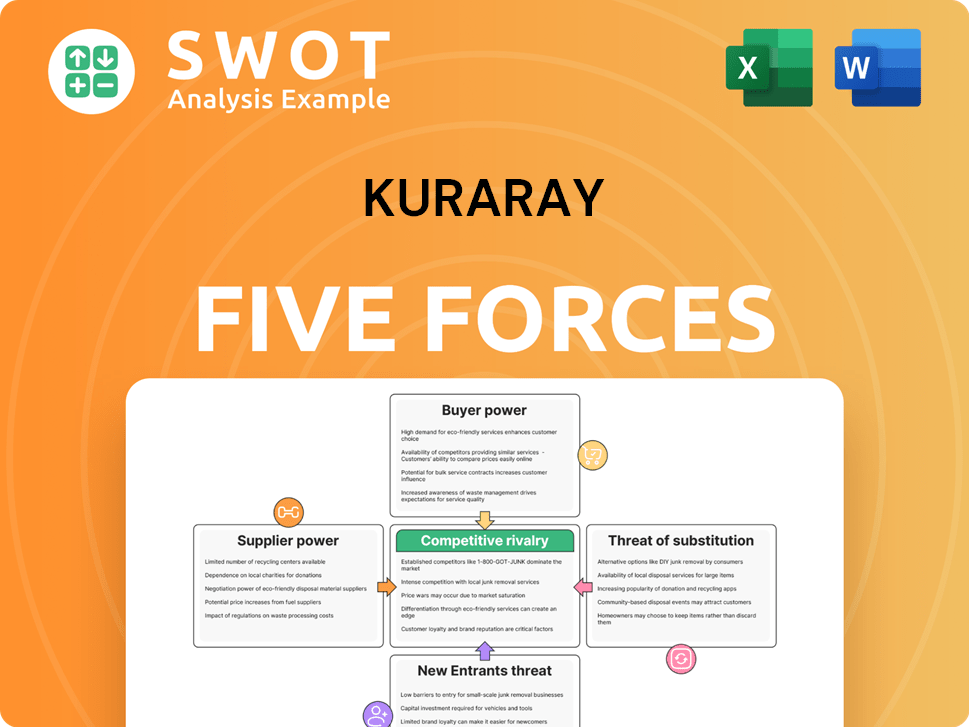
Related Blogs
- What is Competitive Landscape of Kuraray Company?
- What is Growth Strategy and Future Prospects of Kuraray Company?
- How Does Kuraray Company Work?
- What is Sales and Marketing Strategy of Kuraray Company?
- What is Brief History of Kuraray Company?
- Who Owns Kuraray Company?
- What is Customer Demographics and Target Market of Kuraray Company?
Disclaimer
All information, articles, and product details provided on this website are for general informational and educational purposes only. We do not claim any ownership over, nor do we intend to infringe upon, any trademarks, copyrights, logos, brand names, or other intellectual property mentioned or depicted on this site. Such intellectual property remains the property of its respective owners, and any references here are made solely for identification or informational purposes, without implying any affiliation, endorsement, or partnership.
We make no representations or warranties, express or implied, regarding the accuracy, completeness, or suitability of any content or products presented. Nothing on this website should be construed as legal, tax, investment, financial, medical, or other professional advice. In addition, no part of this site—including articles or product references—constitutes a solicitation, recommendation, endorsement, advertisement, or offer to buy or sell any securities, franchises, or other financial instruments, particularly in jurisdictions where such activity would be unlawful.
All content is of a general nature and may not address the specific circumstances of any individual or entity. It is not a substitute for professional advice or services. Any actions you take based on the information provided here are strictly at your own risk. You accept full responsibility for any decisions or outcomes arising from your use of this website and agree to release us from any liability in connection with your use of, or reliance upon, the content or products found herein.